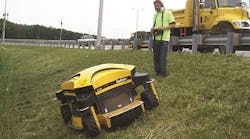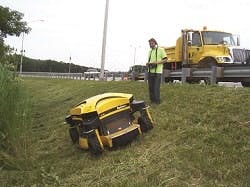Jim Montague is the executive editor for Control, Control Design and Industrial Networking. Email him at [email protected] or check out his Google+ profile.
The coming robot uprising might be arriving sooner than expected. At least, if I was a self-balancing robot spending a long, hot summer cutting weeds along the highway, I might "get smart enough to wonder why I have to take orders" a lot sooner, too. (Quotation is from "The Incredibles" movie, of course.)
SEE ALSO: Top 10 Reasons to Invest in Robots
But, I'm getting ahead of myself. So, a few weeks ago, I was driving west on Touhy Avenue between Park Ridge and Des Plaines, in northwest suburban Chicago. As I come out from under the I-294 overpass, I see what looks like a big, yellow desk-with-wheels rolling around in the thick weeds leading up to the highway above. It looked a lot like a giant Roomba. You know, the Frisbee-shaped, housecleaning, robotic vacuum cleaner.
Well, there are no flies on me yet, so I stopped at a gas station in the next block, walked back up and onto the embankment, and chased after what turned out to be a Spider ILD02 four-wheeled, omni-directional, robotic lawnmower, cutting grass and weeds for the Illinois Tollway Authority. While the robot looked at first as if it was running autonomously, I soon saw it was controlled by a human operator with a fanny pack-style radio-control unit. Pretty nifty.
"We bought a total of eight Spiders, and we've been trying them out in various locations," said Illinois Tollway operator Paul B. "We were a little skeptical about them at first, but the Spiders work great on the slopes."
Illinois Tollway operator Paul B. puts the Spider ILD02 wireless, robotic mower through its paces cutting grass and weeds along the sloped embankment of I-294 in suburban Chicago.
This should probably be no surprise because the Spiders are designed to operate on grades up to 41°, and have winches to work on even steeper terrain up to 55°. Several versions of the Spiders are manufactured by Dvo˘rák Machine Division in the Czech Republic, and assembled and distributed in the U.S. by Slope Care in Orlando, Fla. Besides its widely spaced wheels and light design for a lower center of gravity, Dvo˘rák reports that, "Spider has a hydrostatic drive system that ensures fluent speed regulation, while preserving optimum management of the combustion engine. This combination of sensitive speed regulation and steering results in precise control of the mower, efficient operations and high safety."
The firm adds that Spider's machine travel method is patent-protected and ensures stability, even when changing driving directions on steep slopes. Also, Spiders have a skid steering system that allows the rotation of the mower around its vertical axis, which simplifies manipulation. The wireless control unit operates at 458.800-459.175 MHz in the U.S. and Canada, and has a range of 100 meters.
Control elements in the ergonomic transmitter portion allow Spider ILD02 to start and switch off the engine, preset the traveling speed, engage and disengage the mowing device, adjust the mower's cutting height, change traveling speed and direction, steer wheels 360°, and shut down the whole system in an emergency.
[pullquote]
Meanwhile, the on-unit receiver and power section on the Spider includes its radio receiver; electronic power circuit; servomotors controlling direction, traveling speed and gas; linear electric motors adjusting cutting height; and electromagnetic clutch and mower.
In short, while the revolution could be a little ways off, end users are taking robots and other machines right out of factories, and applying them in all kinds of mainstream applications. Remember the Espresso book printing machine I found out west? ("Printing at Powell's in Portland," Control Design, June '13) Well, these encounters are officially a trend because I was just at the free breakfast buffet at a Holiday Inn in Tulsa last month, and I ran smack into a tabletop Quickcakes machine by American Quick Foods. It was busy automatically spitting out pancakes using little Teflon conveyor belts and several types of sensors, but that's a story for another day. Heck, I haven't even had time to call them up yet.







